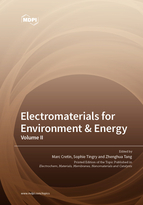Topic Menu
► Topic MenuTopic Editors


Electromaterials for Environment & Energy

A printed edition is available here.
Topic Information
Dear Colleagues,
In a developing world, the demands for energy, water on one side and the damage to the integrity of our environment on the other side are constantly increasing. Electrochemistry can be a great tool to solve these problems, with an impact that we can minimize or at least control in our environment, since the main driver of the reaction is the electron that can be produced by sustainable routes.
In electrochemical approaches of energy conversion and production, as well as in drinking water production or wastewater treatment, materials and interfaces are key pieces that will greatly affect system performance.
The objective of this topic is to propose a set of publications bringing together the trends of current research in the fields of energy, water and environmental pollution treatment, with a focus on the control of the material and interfaces, with a view to the optimization of processes.
Prof. Dr. Marc Cretin
Dr. Sophie Tingry
Dr. Zhenghua Tang
Topic Editors
Keywords
- electro-, photo- and photoelectro-catalysis and associated electrode materials
- dense, porous and/or reactive membranes
- electrochemical advanced oxidation processes for water treatment
- electrochemical valorization of biomass
- energy production (fuel cells, bio-fuel cells)
- hydrogen production (electrolysers)
- desalination
Participating Journals
| Journal Name | Impact Factor | CiteScore | Launched Year | First Decision (median) | APC |
|---|---|---|---|---|---|

Electrochem
|
- | - | 2020 | 22.3 Days | CHF 1000 |

Materials
|
3.4 | 5.2 | 2008 | 13.9 Days | CHF 2600 |

Membranes
|
4.2 | 4.4 | 2011 | 13.6 Days | CHF 2700 |

Nanomaterials
|
5.3 | 7.4 | 2010 | 13.6 Days | CHF 2900 |

Catalysts
|
3.9 | 6.3 | 2011 | 14.3 Days | CHF 2700 |

MDPI Topics is cooperating with Preprints.org and has built a direct connection between MDPI journals and Preprints.org. Authors are encouraged to enjoy the benefits by posting a preprint at Preprints.org prior to publication:
- Immediately share your ideas ahead of publication and establish your research priority;
- Protect your idea from being stolen with this time-stamped preprint article;
- Enhance the exposure and impact of your research;
- Receive feedback from your peers in advance;
- Have it indexed in Web of Science (Preprint Citation Index), Google Scholar, Crossref, SHARE, PrePubMed, Scilit and Europe PMC.


